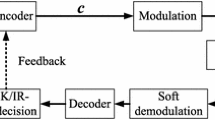Abstract
A hybrid ARQ in which the transmitter adaptively selects an FEC code according to the channel condition is presented and analyzed. The code is selected according to the past transmissions and acknowledgements by an algorithm which is a generalization of that in [1]. The throughput is obtained as a function of the frame error rate for a general system employing the adaptive hybrid ARQ with acknowledgements that arrive instantly on an error-free return channel. The throughput is obtained as a function of the signal-to-noise ratio for an example quad rate system employing convolutional codes with non-coherent frequency shift keying over the uncorrelated Rayleigh fading channel. This allows the best choice for the parameters of the algorithm to be made. In the case that the channel bit errors are independent, the generalization offers performance improvement of less than 10% over that in [1]. But when the channel errors are bursty, as in the case of Rayleigh fading with finite bit interleaving, the generalization offers throughput improvement as high as 24%. We go on to consider incorporating code combining with the adaptive scheme to form an adaptive memory hybrid ARQ. Simulation of a system using complementary punctured convolutional codes with 4 code rates shows that 2-level code combining can extend the adaptive scheme's useful throughput into the low SNR region by approximately 4 dB.
Similar content being viewed by others
References
N. Shacham and A Livne, “An Adaptive Hybrid ARQ Algorithm for Radio Channels”, IEEE International Communications Conference, Vol. 3, pp. 1390–1394, 1985.
S. Lin and J. Costello, Error Control Coding: Fundamentals and Applications, Prentice-Hall: Englewood Cliffs, 1985.
Y. Wang and S. Lin, “A Modified Selective Type II Hybrid ARQ System and Its Performance Analysis”, IEEE Trans. Commun., Vol. 31, pp. 593–607, 1983.
D. Chase, “Code Combining. A Maximum-Likelihood Decoding Approach for Combining an Arbitrary Number of Noisy Packets”, IEEE Trans. Commun., Vol. 33, pp. 385–393, 1985.
H. Krishna and S. Morgera, “A New Error Control Scheme for Hybrid ARQ Schemes”, IEEE Trans. Commun., Vol. 35, pp. 981–989, 1987.
G. Benelli, “A Go-Back-N Protocol for Mobile Communications”, IEEE Trans. Vehic. Tech., pp. 715–720, 1991.
J. Hagenauer, “Rate-Compatible Punctured Convolutional Codes and their Applications”, IEEE Trans. Commun., Vol. 36, pp. 389–400, 1988.
S. Kallel and D. Haccoun, “Generalized Type II Hybrid ARQ Scheme Using Punctured Convolutional Coding”, IEEE Trans. Commun., Vol. 38, pp. 1938–1946, 1990.
M. Kousa and M. Rahman, “An Adaptive Error Control System Using Hybrid ARQ Schemes”, IEEE Trans. Commun., Vol. 39, pp. 1049–1057.
S. Kallel and C. Leung, “Efficient ARQ Schemes with Multiple Copy Decoding”, IEEE Trans. Commun., Vol. 40, pp. 642–650, 1992.
R. Deng and H. Zhou, “An Adaptive Coding Scheme with Code Combining for Mobile Radio Systems”, IEEE Trans. Commun., Vol. 42, No.4, pp. 469–476, 1993.
B. Vucetic, D. Drajic and D. Perisic, “Algorithm for Adaptive Error Control System Synthesis”, IEE Proceedings, Vol. 135 part F(1), pp. 85–94, 1988.
T. Sato, M. Kawabe, T. Kato and A. Fukasawa, “Protocol Configuration and Verification of an Adaptive Error Control Scheme over Analog Cellular Networks”, IEEE Trans. Vehic. Tech., Vol. 41, No.1, pp. 69–76, 1992.
S. Wicker, “Hybrid-ARQ Reed–Solomon Coding in an Adaptive Rate System”, Proceedings of the ICC, pp. 45.5.1–45.5.5, 1989.
M. Rice and S. Wicker, “Adaptive Error Control for Slowly Varying Channels”, IEEE Trans. Commun., Vol. 42, No.2/3/4, pp. 917–926, 1994.
M. Rice and S. Wicker, “A Sequential Scheme for Adaptive Error Control over Slowly Varying Channels”, IEEE Trans. Commun., Vol. 42, No.2/3/4, pp. 1533–1543, 1994.
B. Vucetic, “An Adaptive Coding Scheme for Time-Varying Channels”, IEEE Trans. Commun., Vol. 39, No.5, pp. 653–663, 1991.
M. Ross, Stochastic Processes, John Wiley and Sons Inc.: London, 1983.
Y. Yasuda, K. Kashiki and Y. Hirata, “High Rate Punctured Convolutional Codes for Soft Decision Viterbi Decoding”, IEEE Trans. Commun., Vol. 32, pp. 315–319, 1984.
J. Proakis, Digital Communications, McGraw-Hill: New York, 1983.
W. Jakes, Microwave Mobile Communications, J. Wiley and Sons: New York, 1974.
S. Kallel, “Complementary Punctured Convolutional Codes and their Applications”, IEEE Trans. Commun., Vol. 43, pp. 2005–2009, 1995.
S. Kallel, R. Link and S. Bakhtiyari, “Throughput Performances of Memory ARQ Schemes”, IEEE Trans. Vehicular Tech., 1998, in press.
Author information
Authors and Affiliations
Rights and permissions
About this article
Cite this article
Kallel, S., Bakhtiyari, S. & Link, R. An Adaptive Hybrid ARQ Scheme. Wireless Personal Communications 12, 297–311 (2000). https://doi.org/10.1023/A:1008954000541
Issue Date:
DOI: https://doi.org/10.1023/A:1008954000541




